Fowlow, Norman Ralph
Killed in Action 1944-05-19
Service
RCAF
Unit
411 (F) Sqn- Squadron
Inimicus Inimico Hostile to an Enemy
Base
RAF Tangmere
Rank
Squadron Leader
Position
Squadron Leader
Service Numbers
J/15095
Home
 Windsor, Nova Scotia
Windsor, Nova Scotia
Squadron Leader Fowlow had previously been employed by the Royal Bank of Canada from September 22, 1938 at the Wolfville, Nova Scotia branch, enlisting in the RCAF from here August 22, 1940
Spitfire LF Mk IX MK834
Bombing 1944-May-19 to 1944-May-19
411 (F) Sqn (RCAF) RAF Tangmere
Born 1921 in Hodges Cove, Newfoundland. Enlisted in Halifax, Nova Scotia 22 August 1940. Commissioned 1941. Trained at No1 ITS (graduated 14 December 1940), No11 EFTS (graduated 28 January 1941) and No 2 SFTS (graduated 4 April 1941). Killed in action 19 May 1944
411 Grizzly Bear Squadron (Inimicus inimico) RAF Tangmere. Spitfire LF IX aircraft MK 834 shot down by flak while dive bombing the Railway Crossing at Hazebrough, France, in which Squadron Leader N R Fowlow DFC (RCAF) was killed in action. Fowlow had commenced his diving attack from10,000 feet carrying a 500 lb bomb, but at about 7,000 feet his aircraft was hit by heavy flak exploding the bomb and killing him instantly
Squadron Leader Fowlow DFC had been shot down at sea and rescued, severely wounded, 1942-05-18 while serving with 611 Squadron RAF in Malta. Back in Europe, he later shot down three enemy aircraft while flying with 403 Squadron and one while flying with 421 Squadron
FOWLOW, Squadron Leader Norman Ralph (J15095) - Distinguished Flying Cross - No.421 Squadron. Award effective 9 September 1943 as per London Gazette dated 24 September 1943 and AFRO 2386/43 dated 19 November 1943. The citation reads - "This officer has taken part in a very large number of sorties and has proved himself to be a skillful and courageous fighter. He has destroyed four and shared in the destruction of another enemy aircraft." Detail provided by Hugh Halliday, Orleans, Ontario
Aces High Volume 1 by Christopher Shores and Clive Williams pages 266-7
Canadian Wing Commanders by George Brown and Michel Lavigne pages 81, 137, 152
 Royal Air Force Serial and Image Database
Royal Air Force Serial and Image Database
 Search for France - Crashes 39-45
Search for France - Crashes 39-45
 Squadron Leader "Norm" Fowlow DFC I World War II New...
Squadron Leader "Norm" Fowlow DFC I World War II New...
 Spitfire pilots and aircraft database - Squadron Leader Norman Ralph FOWLOW RCAF
Spitfire pilots and aircraft database - Squadron Leader Norman Ralph FOWLOW RCAF
Supermarine Spitfire
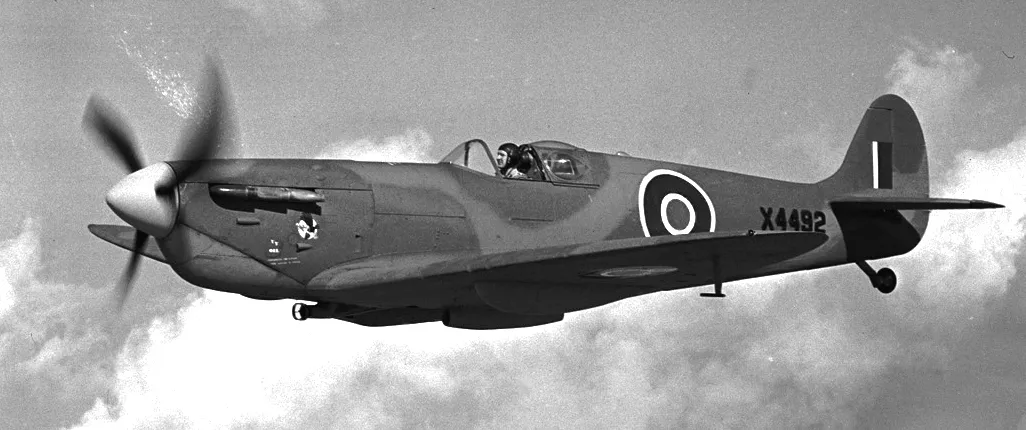
Supermarine Spitfire Mk. VI, RCAF (Serial No. X4492), in flight, 26 Feb 1944.
The Supermarine Spitfire is a British single-seat fighter aircraft that was used by the Royal Air Force and other Allied countries before, during, and after World War II. Many variants of the Spitfire were built, using several wing configurations, and it was produced in greater numbers than any other British aircraft. It was also the only British fighter produced continuously throughout the war. The Spitfire continues to be popular among enthusiasts; around 70 remain airworthy, and many more are static exhibits in aviation museums throughout the world.
The Spitfire was designed as a short-range, high-performance interceptor aircraft by R. J. Mitchell, chief designer at Supermarine Aviation Works, which operated as a subsidiary of Vickers-Armstrong from 1928. Mitchell pushed the Spitfire's distinctive elliptical wing with cutting-edge sunken rivets (designed by Beverley Shenstone) to have the thinnest possible cross-section, helping give the aircraft a higher top speed than several contemporary fighters, including the Hawker Hurricane.
The Spitfire had detachable wing tips which were secured by two mounting points at the end of each main wing assembly. When the Spitfire took on a role as a high-altitude fighter (Marks VI and VII and some early Mk VIIIs), the standard wing tips were replaced by extended, "pointed" tips which increased the wingspan from 36 ft 10 in (11.23 m) to 40 ft 2 in (12.24 m). The other wing-tip variation, used by several Spitfire variants, was the "clipped" wing; the standard wing tips were replaced by wooden fairings which reduced the span by 3 ft 6 in (1.07 m). The wing tips used spruce formers for most of the internal structure with a light alloy skin attached using brass screws.
Due to a shortage of Brownings, which had been selected as the new standard rifle calibre machine gun for the RAF in 1934, early Spitfires were fitted with only four guns, with the other four fitted later. Early tests showed that, while the guns worked perfectly on the ground and at low altitudes, they tended to freeze at high altitude, especially the outer wing guns, because the RAF's Brownings had been modified to fire from an open bolt. While this prevented overheating of the cordite used in British ammunition, it allowed cold air to flow through the barrel unhindered. Supermarine did not fix the problem until October 1938, when they added hot air ducts from the rear of the wing-mounted radiators to the guns, and bulkheads around the gunbays to trap the hot air in the wing. Red fabric patches were doped over the gun ports to protect the guns from cold, dirt, and moisture until they were fired.
The first Rolls-Royce Griffon-engined Mk XII flew in August 1942, and first flew operationally with 41 Squadron in April 1943. This mark could nudge 400 mph (640 km/h) in level flight and climb to an altitude of 33,000 ft (10,000 m) in under nine minutes. As American fighters took over the long-range escorting of USAAF daylight bombing raids, the Griffon-engined Spitfires progressively took up the tactical air superiority role, and played a major role in intercepting V-1 flying bombs, while the Merlin-engined variants (mainly the Mk IX and the Packard-engined Mk XVI) were adapted to the fighter-bomber role. Although the later Griffon-engined marks lost some of the favourable handling characteristics of their Merlin-powered predecessors, they could still outmanoeuvre their main German foes and other, later American and British-designed fighters.Wikipedia
 Wikipedia Supermarine Spitfire
Wikipedia Supermarine Spitfire
 YouTube How the Spitfire Became an Aviation Masterpiece
YouTube How the Spitfire Became an Aviation Masterpiece
 RCAF Supermarine Spitfire Serials - Kestrel Publications
RCAF Supermarine Spitfire Serials - Kestrel Publications
411 (F) Sqn Inimicus Inimico ("Grizzly Bear")
History of the Squadron during World War II (Aircraft: Spitfire Mks. IIA,VB, IXB, IXE, XVI, XIV)
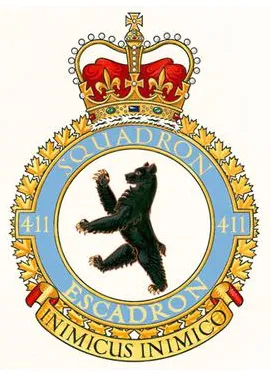
The squadron was the sixth of the RCAF's squadrons to be formed overseas in WWII. It was the fourth fighter squadron to be so formed. It was established at Digby, Lincolnshire, England  on June 16, 1941. It flew Spitfire aircraft in the defence of Great Britain, formed part of the Canadian Kenley Wing within No. 11 Group, Fighter Command, and after D-Day moved to France on June 19, 1944, in a fighter and ground support role. It then supported the Allied armies, moving through France, the Low Countries and Germany. It was one of four RCAF day fighter units retained in Germany as part of the British Air Forces of Occupation before being disbanded at Utersen, Germany
on June 16, 1941. It flew Spitfire aircraft in the defence of Great Britain, formed part of the Canadian Kenley Wing within No. 11 Group, Fighter Command, and after D-Day moved to France on June 19, 1944, in a fighter and ground support role. It then supported the Allied armies, moving through France, the Low Countries and Germany. It was one of four RCAF day fighter units retained in Germany as part of the British Air Forces of Occupation before being disbanded at Utersen, Germany  on March 21, 1946.
on March 21, 1946.
In the course of hostilities, the squadron flew 10,747 sorties for the loss of 48 aircraft and pilots, of whom 4 were killed, 4 wounded, 19 presumed dead. The squadron claimed 84 enemy aircraft destroyed, 3 probably destroyed and 44 damaged. On the ground, they claimed 367 motor vehicles and 26 locomotives. The squadron had 5 aces (shot down 5 or more enemy aircraft), of which Flight Lieutenant R.J. Audet DFC & Bar accounted for 5 enemy aircraft within 2 minutes in a single sortie on Dec 29 1944. He was killed on March 5, 1945, by which time his score had mounted to 11.5, including 2 Me 262 jets. Other aces were: Flight Lieutenant H.C. Trainor DFC & Bar, Flight Lieutenant J.J. Boyle DFC, Squadron Leader E.G. Lapp DFC, and Flying Officer M.G. Graham DFC. Overall, the squadron was awarded 1 DSO, 2 MBE, 2 Bars to DFC, 19 DFCs and 1 MiD. Battle Honours were: Defence of Britain 1941-44, English Channel and North Sea 1942-43, Fortress Europe 1941-44: Dieppe, France and Germany 1944-45: Normandy 1944, Arnhem, Rhine. Wikipedia, Kostenuk and Griffin
Maps for Movements of 411 Squadron 1941-46
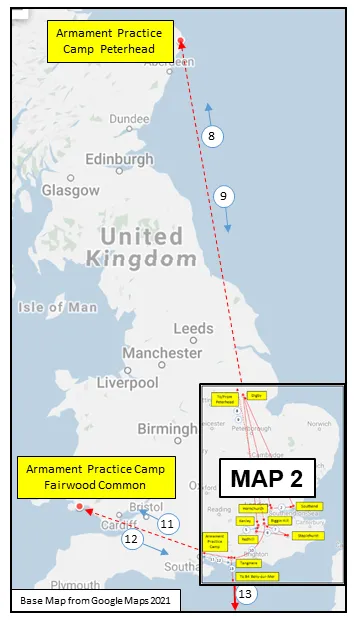 | 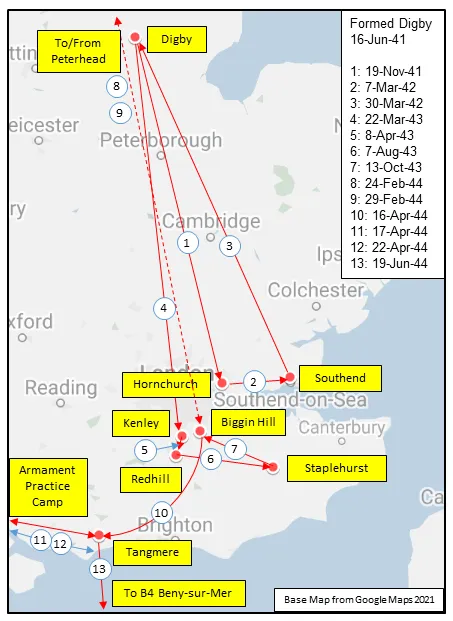 | 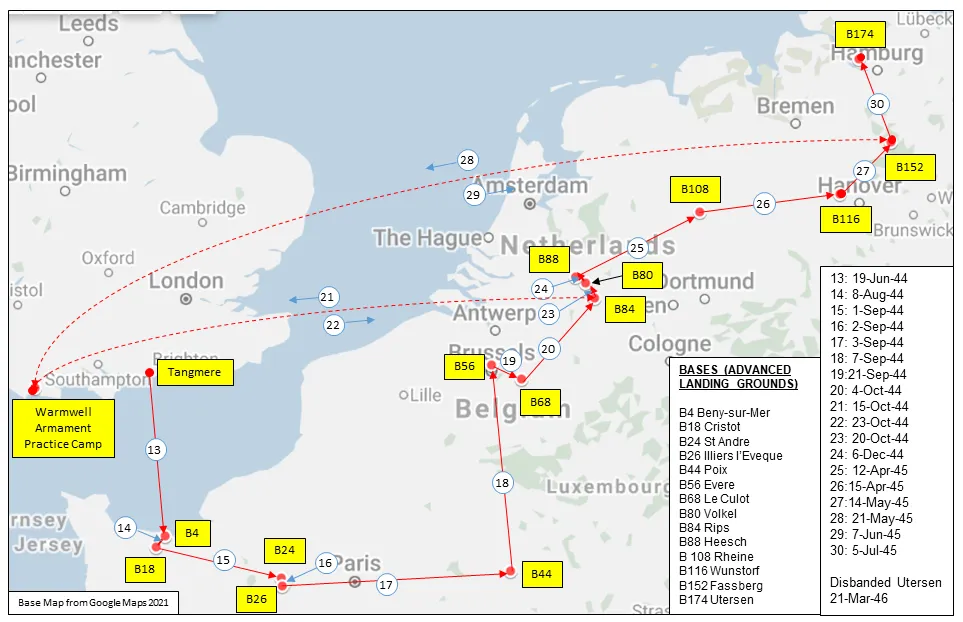 |
411 Squadron History Summary 1941-46
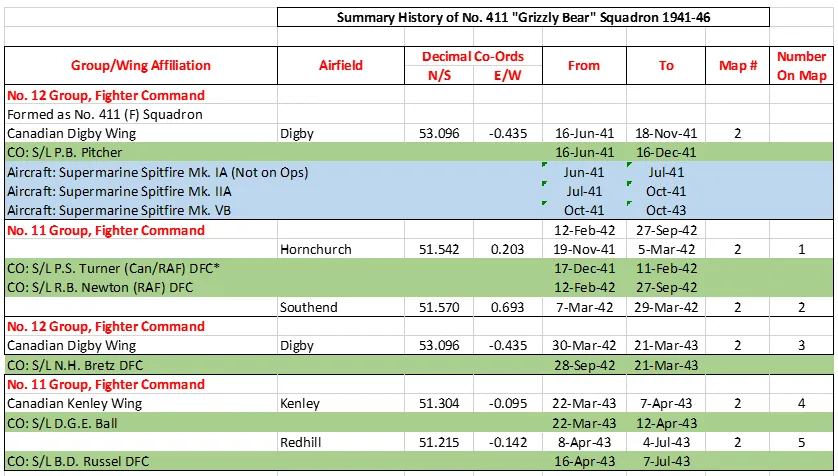
411 Squadron History Summary 1941-46 Page 2
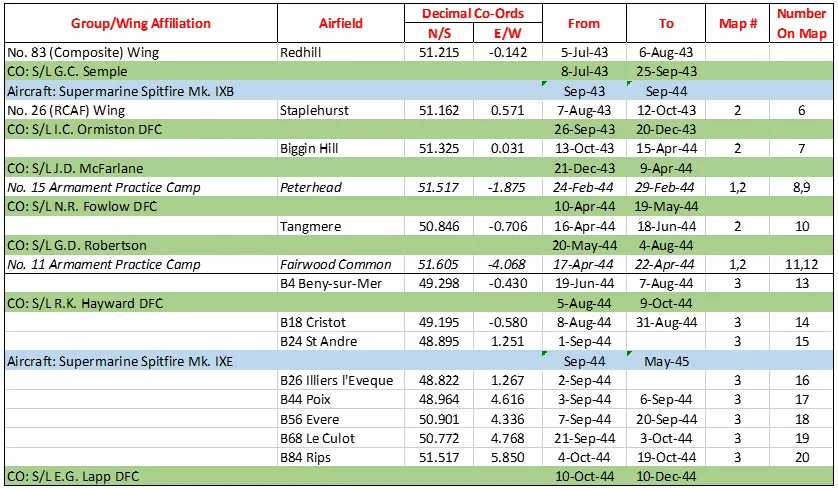
411 Squadron History Summary 1941-46 Page 3
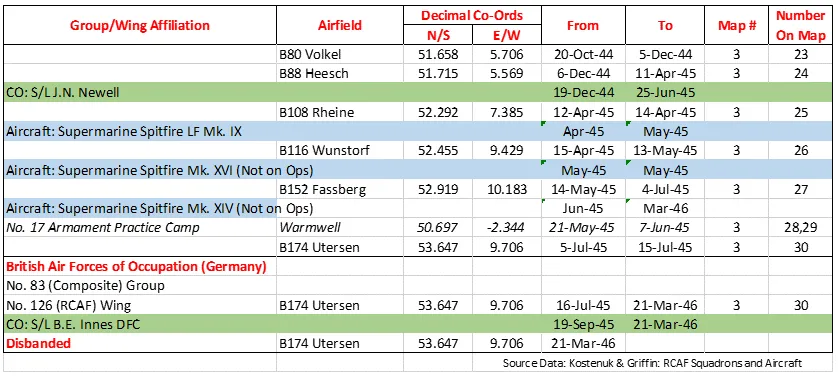
History of the Squadron Post-WWII (Aircraft: Harvard II, Chipmunk, Vampire III, Silver Star, Sabre 5, Expeditor, Otter, Kiowa)
411 Squadron was reformed as an auxiliary fighter squadron at RCAF Station Downsview Ontario  on 1 October 1950, and was known as the ‘County of York’ squadron. With North American Harvards and de Havilland Chipmunks as trainers the squadron operated the de Havilland Vampire III until 1956, then transitioned to the Canadair Sabre Mark V, with the Canadair Silver Star used as a trainer.
on 1 October 1950, and was known as the ‘County of York’ squadron. With North American Harvards and de Havilland Chipmunks as trainers the squadron operated the de Havilland Vampire III until 1956, then transitioned to the Canadair Sabre Mark V, with the Canadair Silver Star used as a trainer.
In October 1958, 411 was moved from Air Defence Command to Air Transport Command, and became a light transport squadron flying the Beech Expeditor C-45. The squadron adopted a Search and Rescue (SAR) role in spring of 1960 with the acquisition of the DHC-3 Otter. The Expeditor was retired in 1966.
On 1 February 1968 the squadron was integrated into the Canadian Armed Forces as No. 411 “County of York†Air Reserve Squadron. In 1969, 411 Squadron was transferred from Air Transport Command to 10 Tactical Air Group, and the squadron's primary role changed to the support of army operations. It continued to hold a secondary SAR role, and to do mapping surveys and sovereignty flights in the Canadian arctic. In 1981, the Otter was retired and the squadron transitioned to the CH-136 Kiowa (OH-58) helicopter, which it operated in a reconnaissance and tactical support role. The squadron finally disbanded on 1 Jan 1998.

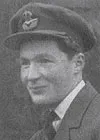


 Canadian Virtual War Memorial
Canadian Virtual War Memorial Commonwealth War Graves Commission
Commonwealth War Graves Commission www.findagrave.com
www.findagrave.com